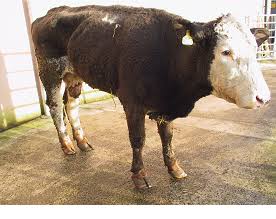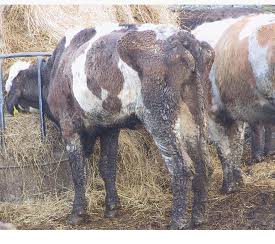Liver flukes, scientifically known as Fasciola hepatica, are tiny parasites that can cause harm to the liver. These creatures may seem small, but their impact on the health of animals and humans can be significant.
Liver flukes have a life cycle that involves different stages. They start as eggs, which hatch into larvae. These larvae then infect snails, where they develop into a different form. After leaving the snail, they transform into another type of larva, which can contaminate plants and water.
When animals or humans consume contaminated plants or water, the liver fluke larvae make their way into the liver, where they grow into mature flukes. These adult parasites can cause damage by feeding on the liver tissue and disrupting its normal function.
The presence of liver flukes can lead to a condition called fascioliasis. Symptoms may include abdominal pain, fever, and sometimes jaundice. In severe cases, liver damage may occur, affecting overall health.
Preventing liver fluke infections involves proper hygiene and avoiding the consumption of raw or undercooked water plants and aquatic animals. It’s crucial to ensure that drinking water is clean and safe.
Treatment for liver fluke infections typically involves medications prescribed by healthcare professionals. Early detection and intervention are essential to prevent further complications.
However, liver flukes, or Fasciola hepatica, may be small parasites, but their impact on liver health can be significant. Understanding their life cycle, practicing good hygiene, and avoiding the consumption of contaminated food and water are crucial steps in preventing and managing liver fluke infections.
Read Also: Rose Chafer: Description, Damages Caused, Control and Preventive Measures
Animals Affected by Liver Flukes (Fasciola hepatica)

Liver flukes can affect various animals, causing health issues and potentially impacting their overall well-being. Cattle, sheep, and goats are commonly affected by these parasites. When these animals graze on contaminated pastures or consume contaminated water plants, they become susceptible to liver fluke infections.
In addition to livestock, wild animals such as deer and rabbits can also be hosts for liver flukes. The parasites’ life cycle often involves snails and other intermediate hosts, creating opportunities for a broad range of animals to become infected.
Furthermore, humans can inadvertently become hosts for liver flukes by consuming raw or undercooked water plants or aquatic animals that harbor the infective larvae. This zoonotic aspect of liver fluke infections highlights the interconnectedness of the health of animals and humans in shared environments.
The impact of liver fluke infections on animals varies but may include symptoms such as weight loss, reduced productivity, and in severe cases, liver damage. Livestock farming practices, such as maintaining clean pastures and providing uncontaminated water sources, play a crucial role in preventing the spread of liver flukes among animals.
Understanding the diverse range of animals affected by liver flukes underscores the importance of comprehensive strategies for parasite control and prevention in both domesticated and wild populations.
Damages Caused by Liver Flukes

Liver flukes, scientifically known as Fasciola hepatica, can inflict significant damage on the liver, impacting both animals and humans. The consequences of liver fluke infections are diverse and can range from mild to severe.
One primary damage caused by liver flukes is the destruction of liver tissue. As these parasites feed on the liver cells, they compromise the organ’s structure and function. This can lead to inflammation, swelling, and a decrease in the liver’s ability to perform essential tasks, such as detoxification and nutrient processing.
In livestock, such as cattle, sheep, and goats, liver fluke infections can result in reduced productivity. Affected animals may experience weight loss, decreased milk production, and impaired reproductive performance. These consequences have economic implications for farmers and can impact the overall health of livestock populations.
In severe cases, chronic liver fluke infections can lead to fibrosis and cirrhosis of the liver. Fibrosis is the formation of scar tissue, and cirrhosis involves the irreversible scarring of the liver. These conditions compromise the organ’s normal structure and function, potentially leading to long-term health issues and even death.
In humans, liver fluke infections can cause a condition known as fascioliasis. Symptoms may include abdominal pain, fever, nausea, and in advanced cases, jaundice. Chronic infections may result in liver damage, posing serious health risks.
Preventing and treating liver fluke infections involve strategies such as proper hygiene, avoiding the consumption of contaminated food and water, and administering anthelmintic medications. Early detection and intervention are crucial to minimizing the extent of damage caused by these parasites.
The damages caused by liver flukes extend beyond the immediate effects on liver health. Livestock productivity, human well-being, and economic factors are all intertwined with the impact of these parasites, emphasizing the importance of effective prevention and control measures.
Read Also: Black Spot (Rose Disease): Description, Damages Caused, Control and Preventive Measures
Control and Preventive Measures
Controlling and preventing liver fluke infections involves implementing a combination of measures to break the life cycle of these parasites and minimize their impact on animals and humans.
1. Pasture Management: Regularly rotating and resting pastures helps reduce the risk of contamination by liver fluke larvae. Avoiding overgrazing and maintaining clean grazing areas can limit exposure for livestock.
2. Water Management: Ensuring a clean and uncontaminated water supply is crucial. Regularly checking water sources for signs of contamination and preventing animals from drinking from potentially contaminated water bodies are essential preventive measures.
3. Hygiene Practices: Practicing good hygiene in livestock farming, including proper waste disposal and maintaining clean living conditions for animals, helps minimize the risk of liver fluke infections. This includes the removal of snail habitats around water sources.
4. Anthelmintic Treatment: Administering anthelmintic medications to animals at appropriate times can help control liver fluke populations. However, it’s essential to follow proper dosage guidelines and consider the potential development of resistance.
5. Quarantine and Testing: Implementing quarantine measures for newly introduced animals and testing for liver fluke infections can prevent the spread of the parasites within a livestock herd. This is especially important when bringing animals from areas with known liver fluke prevalence.
6. Education and Awareness: Educating farmers, veterinarians, and the general public about the risks associated with liver flukes and promoting proper preventive measures is crucial. Awareness campaigns can contribute to early detection and intervention.
7. Safe Food Practices: For humans, practicing safe food handling and ensuring that water plants and aquatic animals are thoroughly cooked before consumption can prevent liver fluke infections.
8. Environmental Control: Implementing measures to control snail populations, which serve as intermediate hosts for liver fluke larvae, can be beneficial. This may include modifying water habitats and using molluscicides in certain situations.
By combining these control and preventive measures, it’s possible to reduce the incidence of liver fluke infections, protect the health of animals and humans, and mitigate the economic impact associated with these parasites. Regular monitoring and adaptation of strategies based on local conditions are key components of effective liver fluke control programs.
Frequently Asked Questions (FAQs) About Liver Flukes (Fasciola hepatica)
Q1: What are liver flukes, and how do they infect animals and humans?
A: Liver flukes, scientifically known as Fasciola hepatica, are parasites that primarily infect the liver. The infection occurs when animals or humans consume contaminated water plants or aquatic animals containing infective larvae.
Q2: Which animals are most commonly affected by liver flukes?
A: Livestock such as cattle, sheep, and goats are commonly affected. Wild animals like deer and rabbits can also be hosts. Humans can become infected by consuming contaminated food or water.
Q3: What are the symptoms of liver fluke infections in animals?
A: Symptoms may include weight loss, reduced productivity, and, in severe cases, liver damage. Livestock may exhibit signs such as decreased milk production and impaired reproductive performance.
Q4: What are the symptoms of liver fluke infections in humans?
A: In humans, symptoms of fascioliasis may include abdominal pain, fever, nausea, and jaundice. Chronic infections can lead to liver damage.
Q5: How can liver fluke infections be prevented in animals?
A: Preventive measures include pasture and water management, good hygiene practices, anthelmintic treatment, quarantine and testing for new animals, and education on liver fluke risks.
Q6: Are liver fluke infections treatable?
A: Yes, liver fluke infections can be treated with anthelmintic medications. Early detection and intervention are crucial to minimize the extent of damage.
Q7: Can liver flukes be transmitted from animals to humans?
A: Yes, liver flukes are zoonotic, meaning they can be transmitted from animals to humans. Humans can become infected by consuming raw or undercooked water plants or aquatic animals.
Q8: What should be done if liver fluke infection is suspected in animals or humans?
A: Seek veterinary or medical attention promptly. Diagnostic tests can confirm the presence of liver flukes, and appropriate treatment can be administered.
Q9: Are there specific regions where liver fluke infections are more prevalent?
A: Liver fluke infections are more common in areas with suitable environmental conditions for the parasite’s life cycle, such as regions with wetlands and water bodies. Prevalence may vary based on geographical and climatic factors.
Q10: How can communities and individuals contribute to preventing liver fluke infections?
A: Communities and individuals can contribute by practicing safe food and water handling, promoting hygiene, participating in awareness campaigns, and implementing environmental control measures to reduce the risk of liver fluke infections.
Read Also: The Different Types of Fertilizers and How they Work

